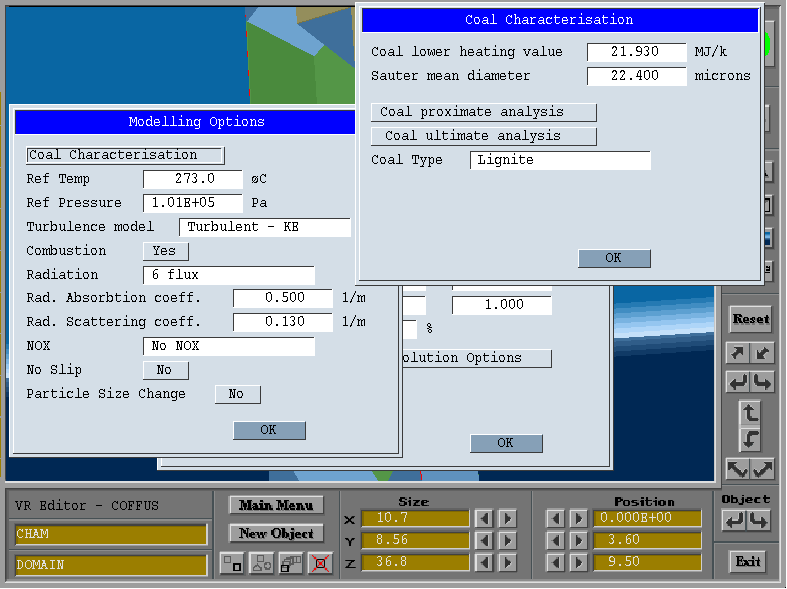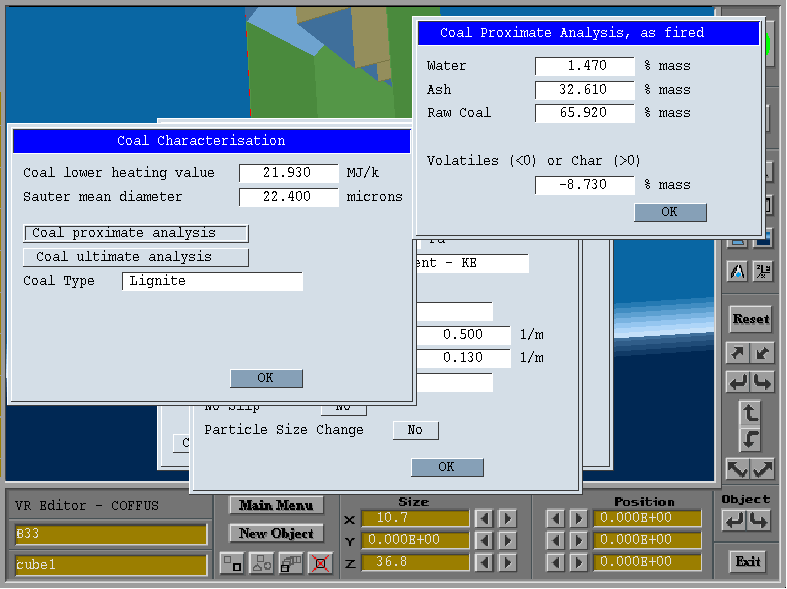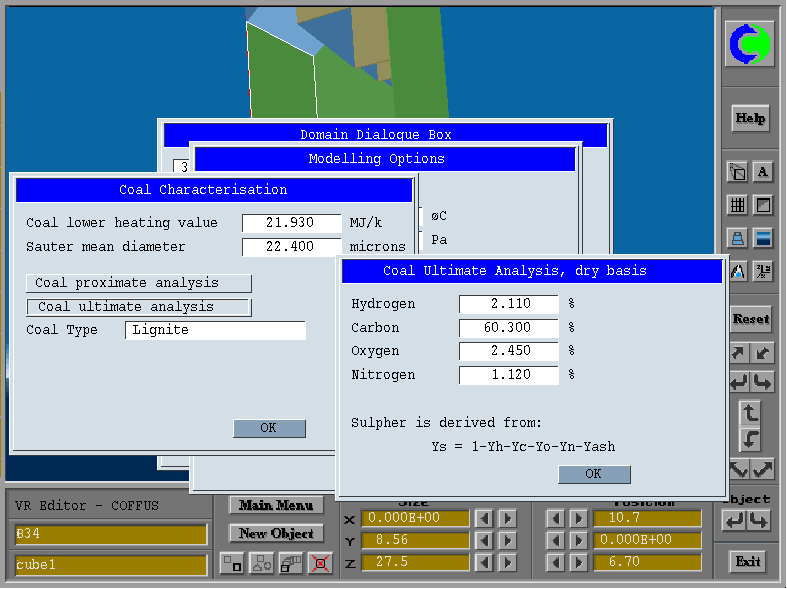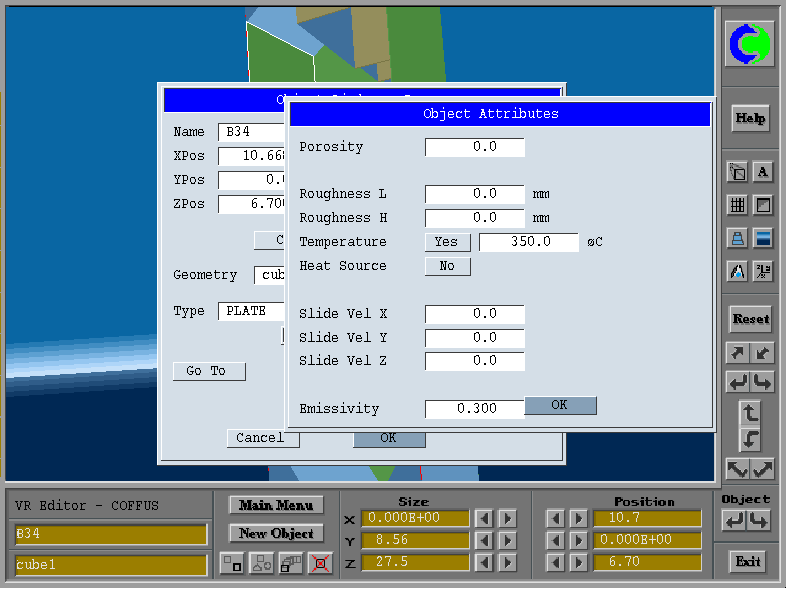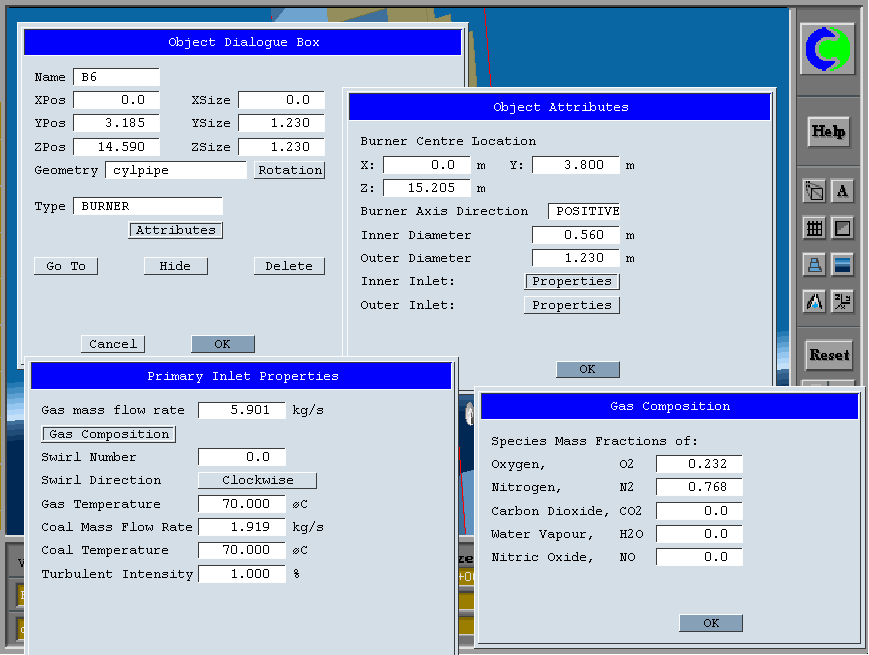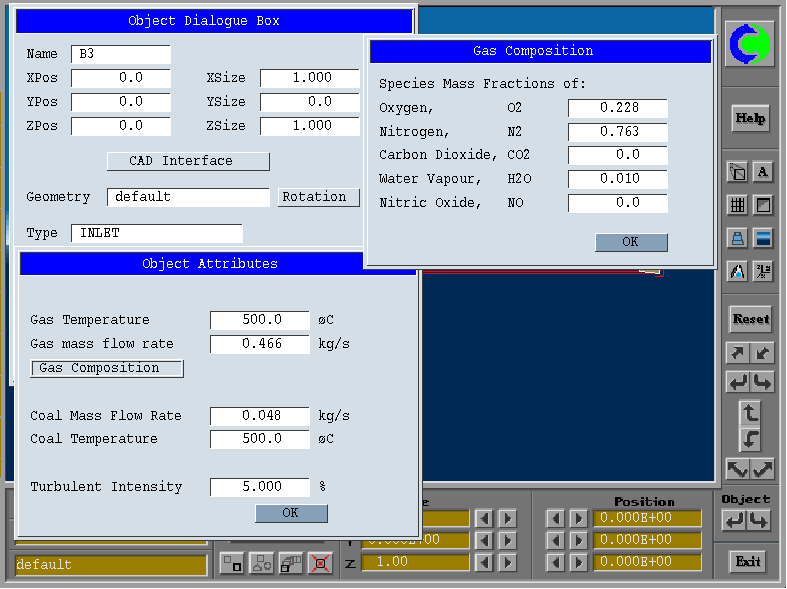1. OVERVIEW OF COFFUS-VR
A 2-phase combustion model has been utilised for COFFUS-VR. This model uses a
2-phase Eulerian-Eulerian description of the gas and solid phases which is based on the
IPSA solution procedure.
The mono-sized particles are assumed to be made up of ash, water, raw coal and char.
The model accounts for slip, coal drying, devolatilisation, char combustion and
pollutant formation due to fuel and thermal NO.
Thermal radiation is accounted for via the 6-flux radiation model.
Further details of the model can be found in MICA Deliverables D1.1 and D1.2.
The COFFUS-VR library contains the cases COFFUS2.Q1 and 1D.Q1, which can be found
in directory:
‘PHOENICS/D_SATELL/D_VRLIBS/MICA/COFFUS’.
These cases were defined by UZ-LITEC; the first case is a simulation of a 350MW
wall-fired power-station furnace, and the second case provides a simple one-dimensional
test of the modelling.
Further examples are required, which might be supplied by LITEC, and there is also the
IFRF example supplied by ESA.
2. HOW TO USE COFFUS-VR
The PHOENICS-VR User Guide (Draft Edition) should be consulted for general information
about running the VR Editor and the VR Viewer.
A library case can be modified by loading it into the VR Editor, as described
above, and modifying the settings by means of the dialogue boxes. Alternatively,
modifications can be made using PIL (PHOENICS Input Language) coding. The two options are
described below.
The following points are intended to highlight aspects of the VR Editor that might
be relevant to a user setting up a furnace simulation.
Two panels are provided, one for 'Modelling Options' and one for 'Solution
Options'. The former is application specific, and it is described below:
The options available are shown below in Figures 1 to 3.
The user can bring up the dialogue box for the "Primary Inlet Properties" by
clicking on the "Inner Inlet Properties" panel, and that for the "Secondary
Inlet Properties" by clicking on the "Outer Inlet Properties" panel.
The swirl velocity, as deduced from the Swirl number and direction, is +ve for
clockwise swirl into the solution domain when using a right-handed coordinate system.
Note that VR currently sets the inlet turbulence intensity to 5%, independent of the
value specified in the dialogue box.
OUTLETs are 2d objects. COFFUS-VR currently assumes that both phases exit through an
outflow boundary. The dialogue box permits user specification of the pressure coefficient
for the gas phase, and the external pressure value (relative to the furnace operating
pressure) which is used by both phases.
The pressure coefficient is usually set to unity, and COFFUS-VR arranges that the
solid-phase pressure coefficient is scaled with the solid-phase density and also that in
the event of inflow, the incoming phasic enthalpies are equal to those in the cell. For
single-phase and non-reacting flow, the default CORE-VR practice is retained, which
requires user specification of the external temperature in oC.
In this version, the computational grid is based on the number of cells in each
direction, specified by the user, and the objects defined.
There is no provision for a fine-grid region to be specified. If the
automatically-calculated grid does not provide enough resolution in some areas, it may be
possible to remedy the defect by creating small null objects; these have no effect on the
problem specification, but introduce additional regions into which (at least) one cell
will be placed.
INLETs are 2d objects which can be used for rectangular or square inlets of gas and/or
coal. At present, this facility is restricted to specifying an orthogonal injection in
terms of the mass flow rate, and as such it does not allow the possibility of an inclined
injection stream of coal and gas.
It is possible for the user to introduce additional functionality by using PIL coding
(with which PHOENICS users have long been familiar). Examples of this approach are
provided for most of the MICA application sectors; these can act as a guide for other
users.
(c) case-specific.
The first type is used for ‘global’ settings related to an application: these
are settings that can be expected to be required in all such cases (although they can be
changed if necessary, by means of case-specific PIL code). The second type is used for
settings that are expected to be required whenever a particular type of object (e.g.
INLET) is used for a particular application. The third type is used for settings (global
or object-related) that are specific to the current case.
COFFUS-VR uses PIL fragments only of the first and third types. The first type is in
the file COFFUS2, which is located in the directory ‘PHOENICS/D_SATELL/D_MEN/MICA/
COFFUS’. Case specific PIL coding is located at the end of the Q1 file for the case
in question; examples can be found in the COFFUS library Q1 files, located in directory
‘PHOENICS/D_SATELL/D_VRLIBS/MICA/COFFUS’.
PIL coding of both types will be included automatically on exit from the VR Editor; the
settings will be included in the Q1 and EARDAT files that are created at that time. If
MONITR=T is inserted at the end of the Q1 file, then for inspection-purposes only,
COFFUS-VR will write a file Q1EAR on leaving the VR Editor; this will contain the input
settings in conventional PIL format.
Note that changes to PIL fragments of the first and second type will only influence
simulations run locally; for remote runs, the standard PIL fragments on the remote machine
will be accessed. Thus, changes for remote runs should always be made at the end of the Q1
file.
The PIL coding in COFFUS2, which defines the DOMAIN settings for COFFUS, is as follows:
Group 8. Terms & Devices
---------------------------------
TERMS(H1,N,P,P,P,P,P)
TERMS(H2,N,P,P,P,P,P)
* Gas-phase mass-fractions (assign variables to phases)
TERMS(YO2,P,P,P,P,Y,P);TERMS(YCHX,P,P,P,P,Y,N)
TERMS(YCO,P,P,P,P,Y,P);TERMS(YCO2,P,P,P,P,Y,P)
TERMS(YH2O,P,P,P,P,Y,P)
* Particle-phase mass-fractions (assign variables to phases)
TERMS(COL2,P,P,P,P,N,P);TERMS(CHA2,P,P,P,P,N,P)
TERMS(WAT2,P,P,P,P,N,P)
CSG3=CNGR
Group 9. Properties
------------------------
REAL(RG56,RG57)
TMP1=GRND2;TMP1A=-TEMP0;TMP1B=1./CP1;ENUL=1.8E-5
RHO2=2590.
TMP1=GRND2;TMP1A=-TEMP0;TMP1B=1./CP1
TMP2=GRND2;CP2=1.8E3;TMP2A=-TEMP0;TMP2B=1./CP2
PRNDTL(H2)=1.E10
RHO1=GRND;TMP1=GRND;RG56=GRND;RG57=2.0
SPEDAT(SET,COFFUS,RG56,R,RG56);SPEDAT(SET,COFFUS,RG57,R,RG57)
TMP1B=1000.;TMP2=GRND2;CP2=1.8/1.E3;TMP2B=1./CP2
TMP1A=0.0;TMP2A=0.0;TEMP0=0.0
* Enthalpies solved in MJ/kg
HUNIT=1.E-6;CP1=CP1*HUNIT
PRNDTL(WAT2)=1.E10;PRNDTL(COL2)=1.E10;PRNDTL(CHA2)=1.E10
Group 10.Inter-Phase Transfer Processes
-------------------------------------------------
INTEGER(ISLIP);ISLIP=ATTRIB(18)
STORE(CFIP);SPEDAT(SET,COFFUS,SMDIAM,R,SMDIAM)
IF(ISLIP.EQ.1) THEN
* No slip; ISLIP=1 (for now high CFIPS, eventually use EQUVEL=T)
+ CFIPS=1.E6
ELSE
* Slip (islip=2)
+ RLOLIM=1.E-5;CFIPS=GRND;;STORE(SLIP,REYN)
+ CINT(YCHX)=0.0;CINT(YO2)=0.0;CINT(YH2O)=0.0;CINT(YCO)=0.0
+ CINT(YCO2)=0.0;CINT(WAT2)=0.0;CINT(CHA2)=0.0;CINT(COL2)=0.0
* Gas-particles heat transfer
+ CINT(H1)=0.0;CINT(H2) =0.0
+ PATCH(LHEATRA,FREEVL,1,NX,1,NY,1,NZ,1,LSTEP)
+ COVAL(LHEATRA,H1,GRND3,GRND3)
+ COVAL(LHEATRA,H2,GRND3,GRND3)
* storage for relaxation of heat source
+ STORE(QDOT);FIINIT(QDOT)=0.0
* special relaxation factors for heat source
+ RELAX(QDOT,LINRLX,1.0)
+ RESREF(QDOT)=0.3;ENDIT(QDOT)=0.3;PRT(QDOT)=1.0;PRNDTL(QDOT)=1.0
+ REAL(THCON);THCON=0.0458;SPEDAT(SET,COFFUS,GASCON,R,THCON)
ENDIF
Group 11.Initialise Var/Porosity Fields
-----------------------------------------------
REAL(HCALC,TREFE,TINI,TCALC)
FIINIT(R2)=1.E-5;FIINIT(R1)=1.0-FIINIT(R2)
FIINIT(YCHX)=0.;FIINIT(YCO)=0.
IF(BURN) THEN
+ FIINIT(YO2) =0.0 ;FIINIT(YH2O)=0.12
+ FIINIT(YN2) =0.73;FIINIT(YCO2)=0.15
ELSE
+ FIINIT(YO2)=0.232;FIINIT(YH2O)=0.
+ FIINIT(YN2)=0.768;FIINIT(YCO2)=0.
ENDIF
FIINIT(ASH2)=1.0;FIINIT(CHA2)=0.0
FIINIT(WAT2)=0.0;FIINIT(COL2)=0.0
TREFE=273.0;TINI=340.
IF(BURN) THEN
+ TCALC=TREFE+600.0
ELSE
+ TCALC=TREFE+TINI
ENDIF
* compute the enthalpy of the air stream
RG57=2.0
HCALC=1.0E-3*0.77*(0.97035+1.493E-4*TCALC/RG57)*TCALC
HCALC=HCALC+1.0E-3*0.23*(1.0802+3.265E-5*TCALC/RG57)*TCALC
FIINIT(H1)=HCALC;FIINIT(H2)=CP2*TCALC
FIINIT(TEMP1)=TCALC;FIINIT(TEMP2)=TCALC
FIINIT(DEN1)=PRESS0/(FIINIT(TEMP1))/287.398
GROUP 13. Boundary conditions and special sources
-----------------------------------------------------------------
COAL DRYING
---------------------
PATCH(VAPORIS0,FREEVL,1,NX,1,NY,1,NZ,1,LSTEP)
COVAL(VAPORIS0,P1,FIXFLU,GRND5);COVAL(VAPORIS0,P2,FIXFLU,GRND5)
COVAL(VAPORIS0,YH2O,ONLYMS,1.0);COVAL(VAPORIS0,H1,ONLYMS,GRND5)
PATCH(VAPORIS2,FREEVL,1,NX,1,NY,1,NZ,1,LSTEP)
COVAL(VAPORIS2,H2,FIXFLU,GRND5);COVAL(VAPORIS2,WAT2,FIXFLU,GRND5)
* Patch to counter the transfer of species due to mass transfer
PATCH(VAPORIS5,FREEVL,1,NX,1,NY,1,NZ,1,LSTEP)
COVAL(VAPORIS5,COL2,GRND9,GRND9);COVAL(VAPORIS5,CHA2,GRND9,GRND9)
COVAL(VAPORIS5,WAT2,GRND9,GRND9)
IF(SIZECH) THEN
+ COVAL(VAPORIS5,PHIS,GRND9,GRND9)
ENDIF
STORE(VAPO);FIINIT(VAPO)=0.0;RELAX(VAPO,LINRLX,1.0)
RESREF(VAPO)=0.3;ENDIT(VAPO)=0.3;PRT(VAPO)=1.0;PRNDTL(VAPO)=1.0
REAL(ADEVOL,EDEVOL,RG55,C1EBU,C2EBU)
INTEGER(IG14,IG16,MODHET,IORDER,IKDMEA)
RAW COAL VOLATILISATION: Raw coal > Y Volatiles + (1-Y) Char
-----------------------------------------------------------------------------------------
IF(BURN) THEN
+ PATCH(DEVOLAT0,FREEVL,1,NX,1,NY,1,NZ,1,LSTEP)
+ COVAL(DEVOLAT0,P1,FIXFLU,GRND1);COVAL(DEVOLAT0,P2,FIXFLU,GRND1)
+ COVAL(DEVOLAT0,YCHX,ONLYMS,GRND1);COVAL(DEVOLAT0,YO2,ONLYMS,GRND1)
+ COVAL(DEVOLAT0,H1,ONLYMS,GRND1)
* Patch for volatile phase-2 species
+ PATCH(DEVOLAT2,FREEVL,1,NX,1,NY,1,NZ,1,LSTEP)
+ COVAL(DEVOLAT2,COL2,FIXFLU,0.0);COVAL(DEVOLAT2,CHA2,FIXFLU,GRND1)
+ COVAL(DEVOLAT2,COL2,GRND1,0.0)
ENDIF
* ADEVOL = constant A * EDEVOL = constant E/R in volat. model
+ ADEVOL=2000.0;EDEVOL=2.3E4/8.130
+ SPEDAT(SET,COFFUS,ADEVOL,R,ADEVOL)
+ SPEDAT(SET,COFFUS,EDEVOL,R,EDEVOL)
* store volatilization rate & special relaxation
+ STORE(VRAT);FIINIT(VRAT)=0.0;RELAX(VRAT,LINRLX,1.0)
+ RESREF(VRAT)=0.3;ENDIT(VRAT)=0.3;PRT(VRAT)=1.0;PRNDTL(VRAT)=1.0
* Use this line to de-activate: devolat=skip;rg(21)=0.0
Patch to counter the transfer of non-volatile species
IF(BURN) THEN
+ PATCH(DEVOLAT5,FREEVL,1,NX,1,NY,1,NZ,1,LSTEP)
+ COVAL(DEVOLAT5,COL2,GRND9,GRND9)
+ COVAL(DEVOLAT5,CHA2,GRND9,GRND9)
+ COVAL(DEVOLAT5,WAT2,GRND9,GRND9)
IF(SIZECH) THEN
+ COVAL(DEVOLAT5,PHIS,GRND9,GRND9)
ENDIF
ENDIF
* Ask litec what this is; suggest better name than IG16
* IG16 = 1 indicates CO as product, =2 indicates CO2
+ IG16=1
+ SPEDAT(SET,COFFUS,IG16,I,IG16)
* Combustion
Ask litec what these are:
CHx + O2 -> CO2 + H20 (Not active)
patch(combustc,phasem,1,nx,1,ny,1,nz,1,1000)
coval(combustc,ychx,fixflu,grnd2)
coval(combustc,yo2,fixflu,grnd2)
coval(combustc,yh2o,fixflu,grnd2)
coval(combustc,yco2,fixflu,grnd2);ig16=2
coval(combustc,h1, fixflu,grnd2)
TWO-STEP HOMOGENEOUS COMBUSTION OF VOLATILES (YCHX)
--------------------------------------------------------------------------------------------
* Ask litec what these are:
Store combustion rate for relaxation
+ STORE(COM1);FIINIT(COM1)=0.0;LITER(COM1)=1;RELAX(COM1,LINRLX,1.0)
+ RESREF(COM1)=0.3;ENDIT(COM1)=0.3;PRT(COM1)=1.0;PRNDTL(COM1)=1.0
CHx + O2 -> CO + H20 seguida por CO + O2 -> CO2
IF(BURN) THEN
+ PATCH(COMBUSTA,PHASEM,1,NX,1,NY,1,NZ,1,LSTEP)
+ COVAL(COMBUSTA,YCHX,FIXFLU,GRND2);COVAL(COMBUSTA,YO2,FIXFLU,GRND2)
+ COVAL(COMBUSTA,YH2O,FIXFLU,GRND2);COVAL(COMBUSTA,YCO,FIXFLU,GRND2)
+ COVAL(COMBUSTA,H1,FIXFLU,GRND2)
+ PATCH(COMBUSTB,PHASEM,1,NX,1,NY,1,NZ,1,LSTEP)
+ COVAL(COMBUSTB,YO2,FIXFLU,GRND2);COVAL(COMBUSTB,YCO2,FIXFLU,GRND2)
+ COVAL(COMBUSTB,YCO,FIXFLU,GRND2);COVAL(COMBUSTB,H1,FIXFLU,GRND2)
ENDIF
* Ask litec what these are:
Store combustion rate for relaxation and products for printout
+ STORE(COM2);FIINIT(COM2)=0.0;RELAX(COM2,LINRLX,1.0)
+ RESREF(COM2)=0.3;ENDIT(COM2)=0.3;PRT(COM2)=1.0;PRNDTL(COM2)=1.0
* Liter=1 selects mixing rate (ep/k) as combustion rate
+ LITER(COM2)=1
* C1EBU & C2EBU = EBU constants in combustion model
+ C1EBU=4.0;C2EBU=0.0
+ SPEDAT(SET,COFFUS,C1EBU,R,C1EBU)
+ SPEDAT(SET,COFFUS,C2EBU,R,C2EBU)
HETEROGENEOUS COMBUSTION OF CHAR C(S) + O2 > CO2
-------------------------------------------------
IF(BURN) THEN
+ PATCH(BURNOUT0,FREEVL,1,NX,1,NY,1,NZ,1,LSTEP)
+ COVAL(BURNOUT0,P1,FIXFLU,GRND5);COVAL(BURNOUT0,P2,FIXFLU,GRND5)
+ COVAL(BURNOUT0,H1,ONLYMS,GRND1)
+ PATCH(BURNOUT2,FREEVL,1,NX,1,NY,1,NZ,1,LSTEP)
+ COVAL(BURNOUT2,H1 ,FIXFLU,GRND5)
+ COVAL(BURNOUT2,YO2 ,FIXFLU,GRND5)
+ COVAL(BURNOUT2,CHA2,FIXFLU,GRND5)
+ COVAL(BURNOUT2,YCO,GRND9,1.0)
* Ask litec what this is:
coval(burnout2,yco2,grnd9,1.0);ig14=2
ENDIF
* Ask litec for clarification of these:
* IG14 = 1 indicates CO as product, =2 indicates CO2
* MODHET = selects kinetic law for heterog. reaction
* IORDER = selects order of heterog. reaction
* IKDMEA = selects kinetic/diffusion weighting
+ IG14=1;MODHET=0;IORDER=0;IKDMEA=0
+ SPEDAT(SET,COFFUS,IG14 ,I,IG14 )
+ SPEDAT(SET,COFFUS,MODHET,I,MODHET)
+ SPEDAT(SET,COFFUS,IORDER,I,IORDER)
+ SPEDAT(SET,COFFUS,IKDMEA,I,IKDMEA)
* storage of rate triggers calculation
+ STORE(BOUT);FIINIT(BOUT)=0.0
** special relaxation practice
+ RELAX(BOUT,LINRLX,4.0);RESREF(BOUT)=0.3
+ ENDIT(BOUT)=1.E-20;PRT(BOUT)=0.1;PRNDTL(BOUT)=1.E+20
* RG55 = ask litec what this is
+ RG55=0.0
+ SPEDAT(SET,COFFUS,RG55,R,RG55)
IF(BURN) THEN
* Patch to counter the transfer of non-combusting species
+ PATCH(BURNOUT5,FREEVL,1,NX,1,NY,1,NZ,1,LSTEP)
+ COVAL(BURNOUT5,COL2,GRND9,GRND9);COVAL(BURNOUT5,CHA2,GRND9,GRND9)
+ COVAL(BURNOUT5,WAT2,GRND9,GRND9)
IF(SIZECH) THEN
+ COVAL(BURNOUT5,PHIS,GRND9,GRND9)
ENDIF
ENDIF
GROUP 16. Termination of iterations
-----------------------------------
* Limit iterations to save cpu time
DO II=12,NPHI
+ IF(LITER(II).GT.8) THEN
+ LITER(II)=8
+ ENDIF
ENDDO
GROUP 17. Under-relaxation devices
----------------------------------
REAL(FACLIN,FACMIN)
IF(SIZECH) THEN
+ FACLIN=0.01;RELAX(PHIS,LINRLX,0.1)
ELSE
+ FACLIN=0.1
ENDIF
RELAX(CFIP,LINRLX,0.3);RELAX(DEN1,LINRLX,0.3)
RELAX(YCHX,LINRLX,FACLIN);RELAX(YO2, LINRLX,FACLIN)
RELAX(YH2O,LINRLX,FACLIN);RELAX(YCO, LINRLX,FACLIN)
RELAX(YCO2,LINRLX,FACLIN);RELAX(COL2,LINRLX,FACLIN)
RELAX(CHA2,LINRLX,FACLIN);RELAX(WAT2,LINRLX,FACLIN)
* Special relaxation practices for sources
* FACMIN = ask litec what this is
FACMIN = 0.9
SPEDAT(SET,COFFUS,FACMIN,R,FACMIN)
GROUP 18. Limits on variables or increments to them
---------------------------------------------------
HCALC=1.0E-3*0.77*(0.97035+1.493E-4*TREFE/RG57)*TREFE
HCALC=HCALC+1.0E-3*0.23*(1.0802+3.265E-5*TCALC/RG57)*TREFE
VARMIN(H1)=HCALC;VARMIN(H2)=CP2*TREFE
VARMIN(R2) =1.E-9
VARMAX(YCHX)=1.0;VARMIN(YCHX)=1.E-6
VARMAX(YCO) =1.0;VARMIN(YCO) =1.E-6
VARMAX(YO2) =1.0;VARMIN(YO2) =1.E-6
VARMAX(YH2O)=1.0;VARMIN(YH2O)=1.E-6
VARMAX(YCO2)=1.0;VARMIN(YCO2)=1.E-6
VARMAX(YN2) =1.0;VARMIN(YN2) =1.E-6
VARMAX(CHA2)=1.0;VARMIN(CHA2)=1.E-6
VARMAX(COL2)=1.0;VARMIN(COL2)=1.E-6
VARMAX(WAT2)=1.0;VARMIN(WAT2)=1.E-8
VARMAX(ASH2)=1.0;VARMIN(ASH2)=1.E-10
GROUP 19. Data communicated by satellite to GROUND
--------------------------------------------------
BOOLEAN(SPEOUT)
REAL(CBETA,YVOL,STCOEF,HEATC,HEATH,HEATC2,HITMUL,RG42,RG91)
REAL(RG100,RG101,RG102,RG103,RG104)
* SPEOUT = T activates special output data
SPEOUT=F
SPEDAT(SET,COFFUS,SPEOUT,L,SPEOUT)
* CBETA * YVOL * STCOEF * HEATC * HEATH * HEATC2
* HITMUL * RG91 ( ask litec what all these are )
CBETA=0.0;YVOL =0.0;STCOEF=0.0;HEATC=0.0
HEATH=0.0;HEATC2=0.0;HITMUL=0.0;RG42 =0.0;RG91=0.0
SPEDAT(SET,COFFUS,CBETA ,R,CBETA)
SPEDAT(SET,COFFUS,YVOL ,R,YVOL )
SPEDAT(SET,COFFUS,STCOEF,R,STCOEF)
SPEDAT(SET,COFFUS,HEATC ,R,HEATC )
SPEDAT(SET,COFFUS,HEATH ,R,HEATH )
SPEDAT(SET,COFFUS,HEATC2,R,HEATC2)
SPEDAT(SET,COFFUS,HITMUL,R,HITMUL)
SPEDAT(SET,COFFUS,RG42 ,R,RG42 )
SPEDAT(SET,COFFUS,RG91 ,R,RG91 )
** Coal size-change calculation
IF(SIZECH) THEN
** LITEC recommend deactivating patch & setting rg100-rg105=0.
PATCH(SIZECHAN,VOLUME,1,NX,1,NY,1,NZ,1,LSTEP)
COVAL(SIZECHAN,PHIS,FIXFLU,GRND7)
ENDIF
* RG100 = minimum size = 5.E-6
* RG101 = factor for breakup during devolatilization =-100.
* RG102 = factor for slip velocity
* RG103 = factor for turbulent kinetic energy
* RG104 = particle swelling =-0.2
RG100=0.0;RG101=0.0;RG102=0.0;RG103=0.0;RG104=0.0
SPEDAT(SET,COFFUS,RG100,R,RG100);SPEDAT(SET,COFFUS,RG101,R,RG101)
SPEDAT(SET,COFFUS,RG102,R,RG102);SPEDAT(SET,COFFUS,RG103,R,RG103)
SPEDAT(SET,COFFUS,RG104,R,RG104)
** Store Nox variables in combustion run
STORE(NO1);STORE(HCN1)
Group 21. Print-out of Variables
--------------------------------
* The following OUTPUT coding is inactive, as currently coded in s5_cof.for
OUTPUT(U2,Y,P,P,Y,Y,Y);OUTPUT(V2,Y,P,P,Y,Y,Y)
OUTPUT(W2,Y,P,P,Y,Y,Y);OUTPUT(R1,Y,P,P,Y,Y,Y)
OUTPUT(R2,Y,P,P,Y,Y,Y)
DO II=15,NPHI
IF(:ISLN(II):/3*3.EQ.:ISLN(II):) THEN
+ OUTPUT(II,Y,P,P,Y,Y,Y)
ELSE
+ OUTPUT(II,Y,P,P,N,N,N)
ENDIF
ENDDO
** NOX Computation Settings
------------------------
** ATTRIB(20) {=1 No NOX} {=2 NOX}
IF(ATTRIB(20).EQ.2) THEN
+ NOXCAL=T
ELSE
+ NOXCAL=F
ENDIF
SPEDAT(SET,COFFUS,NOXCAL,L,NOXCAL)
IF(NOXCAL) THEN
* Deactivate VRAT calculation (volatilization rate)
+ SPEDAT(SET,COFFUS,ADEVOL,R,0.0)
* Store all the previously-solved variables
+ DO II=1,NPHI
+ SOLUTN(II,P,N,P,P,P,P)
+ ENDDO
+ SOLVE(NO1);SOLVE(HCN1)
* CINT's for new variables
+ CINT(NO1)=0.0;CINT(HCN1)=0.0
* Variables are phase 1
+ TERMS(NO1,P,P,P,P,Y,N);TERMS(HCN1,P,P,P,P,Y,N)
* HCN creation from coal
+ PATCH(HCN2FORM,FREEVL,1,NX,1,NY,1,NZ,1,LSTEP)
+ COVAL(HCN2FORM,HCN1,FIXFLU,GRND)
* NO creation from char-bound nitrogen
+ PATCH(HETNOFOR,FREEVL,1,NX,1,NY,1,NZ,1,LSTEP)
+ COVAL(HETNOFOR,NO1,FIXFLU,GRND)
* Fuel-NO formation from HCN
+ PATCH(FUELFORM,FREEVL,1,NX,1,NY,1,NZ,1,LSTEP)
+ COVAL(FUELFORM,NO1 ,FIXFLU,GRND)
+ COVAL(FUELFORM,HCN1,GRND,0.0)
* Thermal-NO formation
+ PATCH(THERMLNO,FREEVL,1,NX,1,NY,1,NZ,1,LSTEP)
+ COVAL(THERMLNO,NO1 ,GRND,GRND)
* NO destruction by homogeneous reaction with HCN
+ PATCH(FUELRHOM,FREEVL,1,NX,1,NY,1,NZ,1,LSTEP)
+ COVAL(FUELRHOM,NO1 ,GRND,0.0)
+ COVAL(FUELRHOM,HCN1,GRND,0.0)
* Heterogeneous reduction of NO on char
+ PATCH(FUELRHET,FREEVL,1,NX,1,NY,1,NZ,1,LSTEP)
+ COVAL(FUELRHET,NO1,GRND,0.0)
+ VARMIN(NO1)=0.;VARMIN(HCN1)=0.;RESREF(NO1) =1.E-15
+ RESREF(HCN1)=1.E-15
+ DO II=1,NPHI
+ OUTPUT(II,P,P,P,P,N,N)
+ ENDDO
+ OUTPUT(NO1 ,P,P,P,P,Y,Y);OUTPUT(HCN1,P,P,P,P,Y,Y)
+ REAL(YNCOAL,RENDNH,TSAPAR,CHAMIN)
* YNCOAL = Mass fraction of N in coal
* RENDNH = Efficiency of transformation of charN to NOx
* TSAPAR = Particle Total Surface Area (TSA) m2/g
* CHAMIN = Cut-off value for char NOx
+ YNCOAL=0.0115;RENDNH=0.15;TSAPAR=1.0;CHAMIN=0.0
+ SPEDAT(SET,COFFUS,YNCOAL,R,YNCOAL)
+ SPEDAT(SET,COFFUS,RENDNH,R,RENDNH)
+ SPEDAT(SET,COFFUS,TSAPAR,R,TSAPAR)
+ SPEDAT(SET,COFFUS,CHAMIN,R,CHAMIN)
